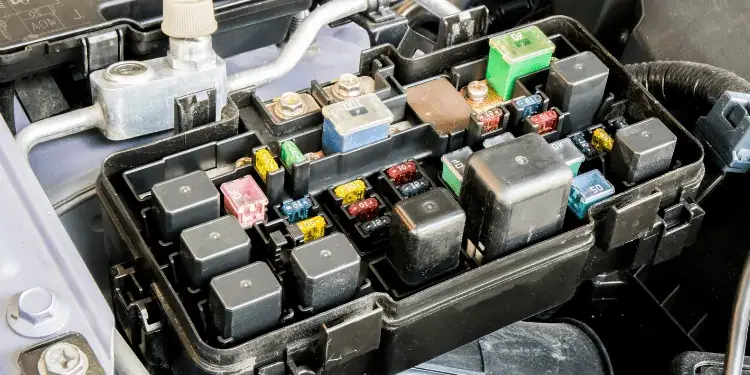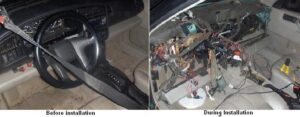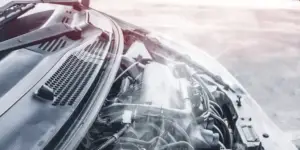Here we’ll discuss the reasons why your engine fan may be running after the engine’s turned off, and how to fix the issue.
It’s important to address this issue as soon as possible, as it can seriously damage your vehicle’s engine.
Why your engine fan may be running after the engine’s turned off
This could be due to several potential causes, such as a bad cooling fan relay, leaking coolant, faulty powertrain control module (PCM) or Electronic Control Unit (ECU), low coolant levels, cracked radiator or radiator hoses, faulty electrical wiring, leaking thermostat unit, overheating engine, leaking heater core, or a faulty cooling fan.
Diagnosing and repairing the issue quickly is important to prevent further damage to your vehicle.
Bad Cooling Fan Relay
Is the cooling fan relay not working correctly? If so, it could be the reason why the vehicle isn’t cooling down when it’s shut off.
The cooling fan relay, also known as the engine fan relay, is the component responsible for controlling the engine fan. When it’s not functioning correctly, it can lead to the engine fan running even after the engine is off, leaving the vehicle unable to cool down.
If the cooling fan relay is malfunctioning, it can cause the check engine light and engine light to come on.
If the relay is faulty, it will need to be replaced to prevent the engine fan from running unnecessarily.
Leaking coolant
Coolant is seeping out, leaving a tell-tale puddle underneath your vehicle and causing it to overheat. The radiator fan might not be working correctly, and the coolant level could be low.
This could indicate a water pump issue, or a leaking coolant hose. Poor maintenance can also be a factor in the leaking coolant, as the coolant hoses and water pump can become brittle and lead to cracks or leaks.
If the water pump is the issue, it’s important to replace it as soon as possible, as the coolant can cause further damage to the engine. If the coolant hoses are the issue, they should be replaced and inspected regularly.
If the radiator fan is the cause, it should be checked by a professional to ensure that it’s working properly.
Faulty powertrain control module (PCM) or Electronic Control Unit (ECU)
The powertrain control module or ECU can be a real headache, leaving you stranded and powerless to get your vehicle back up and running. If you’re having car fan running when the engine is off, it’s possible that the PCM or ECU is faulty.
Here are four things to check for:

- Check the engine control module for any electrical issues.
- Check the temperature switch or sensor for any signs of damage or malfunction.
- Inspect the wiring connections for any signs of corrosion or rust.
- Ensure the PCM or ECU is the correct model and programmed correctly for your vehicle.
If any of the above problems are present, it’s best to have a mechanic or technician take a look and diagnose the issue. They’ll be able to tell you if the PCM or ECU is the issue and suggest a possible resolution.

If a new PCM or ECU is needed, it’s important to make sure it’s the right model and programmed properly for your vehicle. Otherwise, it could cause more problems and damage to your vehicle.
Low Coolant Levels
Worrying about low coolant levels can leave you feeling helpless and frustrated. Understanding the signs of low coolant levels and how to address the issue is important. Low coolant levels can cause your engine to overheat, which can cause a variety of issues.
One of the most common signs of low coolant levels is your radiator fan running after the car has been turned off. This is because the coolant temperature switch is not getting the signal from the coolant temperature sensor to turn off the fan.
To address the issue of low coolant, you should first check the coolant level in the radiator. If it is low, you should top it up with the correct type and amount of coolant for your vehicle.
If the coolant level is okay, you should check the coolant temperature switch and the coolant temperature sensor. If either of these are faulty, they could send the wrong signal to the fan, causing it to run after the car is turned off. Replacing the faulty parts should resolve the issue.
| Coolant Component | Description |
|---|---|
| Engine Overheating | When the coolant levels are low, the engine may overheat. |
| Low Coolant | The coolant level in the radiator should be checked periodically to make sure it is not low. |
| Coolant Temp | The coolant temperature switch and the coolant temperature sensor should be checked to make sure they are working properly. |
| Coolant Temp Switch | The coolant temperature switch is responsible for sending the signal to the fan to turn off when the car is turned off. |
| Radiator Fan | The radiator fan should not run after the car is turned off if the coolant levels are okay and the coolant temperature switch and sensor are working correctly. |
Cracked Radiator or Radiator Hoses

Now that you’ve checked your coolant levels, another possible cause of your car fan running when the engine is off is a cracked radiator or radiator hoses.
Your radiator is a key component of your car’s engine cooling system. It circulates coolant throughout the engine and regulates the coolant temperature.
The radiator hoses, meanwhile, are responsible for transporting the coolant from the radiator to the engine and back again. If either of these components are cracked, the coolant can leak out and prevent the engine cooling fan from performing its job properly.
In order to diagnose whether a cracked radiator or radiator hoses cause your car fan to run when the engine is off, you’ll need to examine both components carefully.
Start by checking the radiator hoses for any visible signs of cracking or damage, such as tears, bulges, or breaks. If you notice any anomalies, inspect the hoses more closely to determine the severity of the damage.
If the hoses are not cracked, then move on to the radiator. Look for any signs of corrosion, leaks, or other damage. If any of these issues are present, you’ll need to replace the radiator or radiator hoses to ensure that your engine cooling fan is functioning properly.
Faulty Electrical Wiring
If none of the above issues are present, it could be that your car’s electrical wiring is to blame for the fan not turning off. This could be because the wiring has become damaged, corroded, or incorrectly connected.
Loose connections can cause excess heat to build up in the engine compartment, preventing the cooling fan from working properly. The fan may run continuously, leading to excessive power consumption and a decrease in overall engine performance.
It’s important to inspect all of the wiring in the engine compartment, including those related to the cooling fan, particulate filter, and any other components. Check for any frayed wires, disconnected connectors, or other signs of damage.
If you find any, it’s best to have the wiring repaired or replaced, as this can help reduce the risk of future electrical issues.
Leaking Thermostat Unit
Wondering why your vehicle won’t cool down? It could be due to a leaking thermostat unit.
If the thermostat unit has a crack or is leaking, then it will not control the flow of the coolant. This can cause the car’s engine to become too hot and the temperature gauge to rise. The high-flow fan will also stay on when the engine is off, which is an indication that the thermostat unit is not functioning properly.
To diagnose the problem, you can try to check the thermostat unit for any cracks or leaks. If there are no signs of damage, the thermostat unit may need replacing.
Another symptom of a faulty thermostat unit is a lack of heat coming from the heater core. If the thermostat is not regulating the flow of coolant, then the heater core will not be able to properly warm the vehicle’s cabin.
Overheating Engine
Is your vehicle’s temperature gauge rising? It could be due to an overheating engine.
If your engine is running much longer than usual, or if you smell a burning odor, these are signs that your engine is getting too hot.
Overheating can be caused by a cracked radiator, a malfunctioning cooling fan, or a malfunctioning thermostat. If your engine fan is running while the car is off, this is a sure sign that your engine fan is not functioning properly and needs to be replaced.
Also, if your air conditioning is not working properly, this could be causing your engine to overheat.
All of these issues can be fixed by an experienced mechanic, but it’s important to address them before they become more serious.

Leaking Heater Core
Have you noticed a strange smell coming from your car’s vents? It could be a sign that your heater core is leaking.
The heater core is a small radiator-like device that’s typically located in the dash of your car. It’s connected to the engine cooling system and its normal operation is to help warm the inside of the car on colder days. The heater core is also connected to the car fan and on a hot day, it circulates fresh air into the cabin of your car.
Leaking heater cores are not always obvious, but they can cause a number of problems. Most commonly, a leaking heater core will cause the car’s fan to run even when the engine is off.
In addition, a leaking heater core can also cause a sweet smell to come from the car’s vents, and sometimes, you may even see a small amount of liquid leaking from the dashboard. If you suspect your car’s heater core is leaking, it’s important to have it inspected and repaired as soon as possible.
Faulty Cooling Fan
You thought you had it figured out when you noticed a leaky heater core, but it turns out the problem could be a faulty cooling fan.
If the fan isn’t working correctly, it can lead to a variety of issues with your engine, including:
- Overheating
- Poor fuel economy
- Damage to the engine
A faulty cooling fan can cause serious problems for your engine, as it provides airflow to the radiator and cools the engine.
If the fan is not working correctly, the air flow can be disrupted, causing the engine to overheat.
This can lead to poor fuel economy, as the engine won’t be able to run as efficiently, and it can also cause damage to the engine if it’s allowed to overheat.
In some cases, the fan may need to be replaced, or the wiring may need to be fixed.
It’s important to check the fan regularly to ensure it’s working correctly.
How To Fix An Engine Fan That Continues Running
To fix an engine fan that continues running, start by disconnecting and reconnecting the battery. This will reset the fan’s circuitry and the car’s computer system.
Next, top up the coolant and test the fan relay. You can swap it with another relay or use a voltmeter to check its functionality.
Finally, inspect the fan for any damage or obstruction that could be preventing it from turning off.
Make sure to give each complete sentence its own line with a double new line after. Don’t forget to use contractions!
Disconnect and Reconnect The Battery
By disconnecting and reconnecting the battery, you’re taking an important step to ensure your vehicle’s safety.
It’s important to remember that disconnecting the battery will cause any electrical components, such as the car’s radio, clock, and power windows, to reset. If the fan is still running after the battery is disconnected, the problem is likely related to the fan motor itself.
When reconnecting the battery, using the proper tools and safety gear is best. If a wrench is used to disconnect the battery cables, wear gloves and eye protection to protect yourself from sparks or flying debris.
Also, make sure to remove the negative cable first and reconnect it last, as this will help to reduce any potential damage to the vehicle’s electrical system.
Top Up Coolant
Topping up your coolant is an easy way to keep your vehicle running smoothly and safely – don’t forget to do it regularly!

Topping up your coolant is a simple task that can be done in a few steps. First, make sure to check your vehicle’s manual to find the exact type of coolant required for your car, as there are different types of coolant for different makes and models.
You’ll also need to make sure that you have the right tools and equipment to properly top up the coolant. Once you have all the necessary items, you should locate the coolant reservoir and remove the cap.
Add the coolant slowly until it reaches the marked level in the reservoir. Make sure to replace the cap and tighten it securely to avoid any leakage.
Finally, check the coolant’s level again and ensure it hasn’t dropped below the marked level. By following these steps, you can easily and safely top up your coolant and keep your vehicle running without any trouble.
Test Fan Relay by Swapping or Voltmeter
You can quickly test the fan relay by swapping it out or using a voltmeter to see if it’s working properly.
To test the fan relay with a voltmeter, set the meter to measure DC Voltage and then connect the negative lead to the negative terminal of the relay while connecting the positive lead to the relay’s ground terminal.
The voltage should measure between 12 and 14 volts. If it’s not, the relay is defective and must be replaced.
If you choose to swap out the fan relay, you’ll need to find a replacement that matches the specifications of the original.
To do this, you’ll need to check the model and make of the car, as well as the type and size of the fan relay. Once you have a replacement, you can install it by connecting the negative and positive terminals to the fan’s negative and positive terminals, respectively.
Make sure to secure the relay in place with the appropriate screws and check that the fan runs properly.
Check the Fan For Damage or Obstruction
Inspecting your vehicle’s fan is essential for keeping it running smoothly. Make sure your engine is off, and the car is in park before you begin.
Visually inspect the fan for any physical damage or corrosion. If you notice any issues, replace the fan as soon as possible.
Check for any foreign objects that may be obstructing the fan. Remove any debris you find and clean out the fan and its surrounding area if possible.
Start the engine to ensure the fan is running properly after you’re done.
Check Thermostat
Verify that the thermostat isn’t causing the problem by making sure it’s functioning correctly.
Check to see if the thermostat is set to the ‘on’ position. The fan should be running if it is in the ‘on’ position.
If the thermostat is set to the ‘off’ position, it means the fan is off and won’t come on until the engine is running.
It’s also possible to have the thermostat set to the ‘auto’ position, in which case the fan will only run when the engine is on and the temperature reaches a certain level.
Check the thermostat to make sure it is properly connected and not broken. If the thermostat is broken, it can cause the fan to run even when the engine is off.
Check the wires running to the thermostat and make sure they are connected properly.
If the thermostat isn’t working or the wiring is faulty, it’s best to replace the thermostat with a new one to ensure the fan works correctly.
Frequently Asked Questions
Is it dangerous for the engine fan to be running when the engine is off?
It isn’t necessarily dangerous for your engine fan to be running when the engine is off, but it can be a potential indication of a problem.
This can depend on the type of engine fan you have, but generally, it should not be running when the engine is off.
If it is, you should check the fan and its connections to ensure everything works properly.
If the fan is still running, then you should have a qualified mechanic inspect the engine and the fan to determine whether the fan is running correctly.
Is it normal for the engine fan to run for a short period of time after the engine has been turned off?
It’s normal for an engine fan to run for a short period of time after the engine has been turned off.
This is because the fan helps cool down the engine and prevents it from overheating. The fan runs until the engine has cooled down to an appropriate temperature.
It’s usually a sign of a well-functioning cooling system if the fan runs for a few minutes after the engine has been turned off.
How often should I check my engine fan for any problems?
You should check your engine fan for any problems on a regular basis.
At least once a month, take a look at the fan belt, any visible cracks or signs of wear and tear, and ensure it’s properly lubricated.
Additionally, inspect the fan blades for any signs of damage or debris that could be causing an obstruction.
What are the signs of an engine fan malfunction?
When it comes to engine fan malfunction, there are several warning signs to look out for.
If your fan is running continuously even when your engine is off, it’s likely a sign that the fan clutch has failed.
You should also be aware of any strange noises coming from the fan, such as grinding or scraping.
In addition, any visible damage to the fan blades can be an indication of a malfunction.
Finally, be sure to keep an eye on the temperature gauge; if it’s running higher than usual, it could be a sign that the fan isn’t doing its job properly.
What are the potential causes of an engine fan running when the engine is off?
When an engine fan is running when the engine is off, it could be caused by a few different issues.
It could be a mechanical issue, such as a broken fan belt or an issue with the fan motor.
It could also be an electrical issue, such as a faulty fan temperature sensor or a short in the wiring.
Finally, it could be an issue with the engine cooling system, such as a stuck thermostat or a clogged radiator.
A mechanic should be consulted to determine the exact cause of the fan running when the engine is off.
Turbo Cooling
A car turbo can operate above 1800 Fahrenheit and needs to cool down at the end of a long drive. Some mechanics recommend letting the car idle for a couple of minutes to allow the fan to get rid of the heat.

Conclusion
Are you wondering why your car’s fan is still running even after you’ve turned off the engine?
It’s likely that the thermostat is stuck in the open position. But don’t worry, there’s an easy fix!
Start by checking the thermostat to see if it’s blocked or stuck. If it is, replacing it should stop the fan from running.
If that doesn’t work, you may need to check the cooling system for any blockages or leaks.
With a few simple steps, you can get your car’s fan running correctly again. So don’t put off any repairs – the longer you wait, the more likely you are to cause further damage to your car.
Put your mind at ease and get your car running like it should today.
Diesel Particulate Filter -Also known as a DPF and Cooling Fan Relationship
Modern diesel cars have a part called a particulate filter. Its job is to stop soot and ash from escaping through the tailpipe. It’s an Eco-friendly fitting that cuts down on pollution. When the filter becomes full, it regenerates.

This generally works well, but sometimes the hood release mechanism triggers the fan from turning on some cars. It’s a safety feature.
Will the Cooling Fan Drain the Battery?
The battery provides all the power to your car when the engine is off. If the fan is still running, it will eventually fully discharge the car battery.






![Car Temperature Gauge Stays On Cold - [ALL CAUSES] Cold-temperature-gauge](https://carzaza.com/wp-content/uploads/2023/12/Cold-temperature-gauge-300x161.png)






